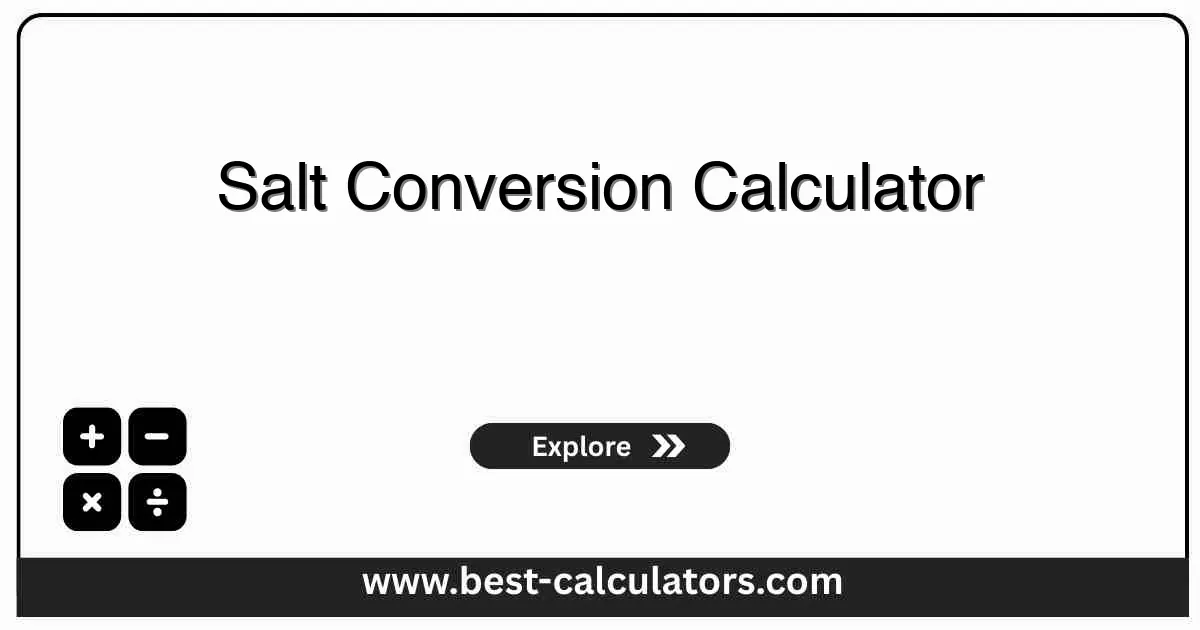Salt Conversion Calculator - Convert Between Table Salt, Kosher Salt & Sea Salt
Free calculator to convert between different salt types with accurate volume conversions for cooking and baking
Salt Conversion Calculator
Conversion Result
Salt Type Comparison Chart
| Salt Type | Crystal Size | Density | 1 Tbsp ≈ | Common Use |
|---|---|---|---|---|
| Table Salt | Fine | 1.0 (ref) | 18g | Baking, Cooking |
| Kosher Salt | Large Flakes | 0.67 | 12g | Seasoning Meats |
| Sea Salt | Medium | 0.83 | 15g | Finishing, Baking |
| Himalayan Pink | Medium | 0.83 | 15g | Gourmet Use |
Weights vary by brand and crystal size. Use these values as general guidelines. For precise cooking, weigh salt on a kitchen scale.
What is a Salt Conversion Calculator?
A salt conversion calculator is a free culinary tool that helps you convert between different types of salt including table salt, kosher salt, sea salt, and Himalayan pink salt. It accounts for differences in crystal size and density to ensure accurate measurements in your recipes.
This calculator helps with:
- Accurate conversions - Convert between different salt types with precision
- Recipe adaptation - Substitute one salt type for another in recipes
- Cooking consistency - Maintain proper seasoning levels across different salts
- Baking accuracy - Ensure precise measurements for baked goods
- Cost optimization - Use whatever salt you have on hand
Related Tools: For general measurement conversions, use our Cooking Measurement Converter. For converting ingredient weights, try our Ingredient Volume-to-Weight Converter.
How Salt Conversion Calculator Works
The calculation uses density ratios between salt types:
Where:
- Density Ratio = Density of target salt ÷ Density of source salt
- Table Salt = Finely ground, highest density (reference: 1.0)
- Kosher Salt = Larger crystals, lower density (~0.67)
- Sea Salt = Variable density (~0.83)
- Himalayan Salt = Similar to sea salt (~0.83)
Key Concepts Explained
Crystal Size
Different salts have different crystal sizes. Table salt is finely ground, while kosher salt has large flakes. This affects how much salt fits in a cup.
Density Differences
Density refers to how much salt fits in a given volume. Finer salts are denser, so you need more coarse salt to get the same sodium content.
How to Use This Salt Conversion Calculator
Select From Salt
Choose the type of salt you currently have (table, kosher, sea, or Himalayan)
Select To Salt
Choose the type of salt you want to convert to
Enter Amount
Input the amount in cups you want to convert
Get Result
View the converted amount and conversion ratio
Benefits of Using This Calculator
- • Accurate Conversions: Get precise measurements when substituting salt types in recipes.
- • Recipe Flexibility: Use whatever salt you have on hand without ruining your dish.
- • Cost Savings: Avoid wasting ingredients by using the right conversion ratios.
- • Professional Results: Achieve consistent seasoning levels in your cooking and baking.
- • Time Saving: No more guessing or looking up conversion charts manually.
Factors That Affect Your Results
1. Crystal Size Variation
Different brands of the same salt type can have slightly different crystal sizes, affecting density and conversion ratios.
2. Moisture Content
Some sea salts contain moisture, which can affect volume measurements. Always use dry measurements for best accuracy.
3. Packing Density
How you measure salt (scooped vs. spooned) can affect the amount. Use consistent measuring methods for best results.

Frequently Asked Questions (FAQ)
Q: How do I convert between different types of salt?
A: Salt conversion depends on crystal size and density. Use this calculator to get accurate conversions based on standard density ratios between different salt types.
Q: Why do I need different amounts of different salts?
A: Different salts have different crystal sizes. Kosher salt has larger crystals than table salt, so you need more kosher salt by volume to get the same sodium content.
Q: Can I use this calculator for all types of salt?
A: This calculator covers table salt, kosher salt, sea salt, and Himalayan pink salt. For specialty salts, you may need to adjust based on the specific product's density.
Q: How accurate are salt conversions?
A: Salt conversions are approximate and can vary by brand. This calculator provides general guidelines for cooking. For precise applications, measure by weight rather than volume.
Q: Should I measure salt by weight or volume?
A: For maximum accuracy, measuring by weight is best. However, this calculator provides volume conversions for convenience when following recipes that use cup measurements.
Q: What if my salt isn't listed?
A: For unlisted salts, use sea salt as the closest approximation. Check the salt's packaging for density information or measure by weight for best accuracy.